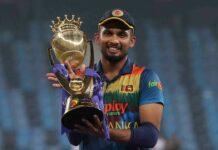Alongside little Romesh Kaluwitharana, Sanath Jayasuriya redefined the manner in which the first 15 overs were approached in One-Day International cricket.
During the 1992 World Cup, Mark Greatbatch had shown the way by hitting fearlessly over the top when the field restrictions were in place at the start of the innings. Four years on, Arjuna Ranatunga decided to double the dosage, giving Jayasuriya and Kaluwitharana the license to go out and have a blast.
As well as Jayasuriya performed that role in Sri Lanka’s epochal march to the World Cup title, there was more to him than just being an ODI dasher. He is Sri Lanka’s first triple centurion in Test cricket, finishing with an average of 40.04 from 110 Tests. Despite having started his ODI career lower down the order, he amassed 13,430 runs from 445 games at 32.36, slamming 28 centuries and striking at 91.20 per 100 deliveries faced. As if that wasn’t enough, he also picked up 98 Test wickets and 323 wickets in ODIs, a genuine allrounder who also led his country with distinction.
Jayasuriya, who was two days short of his 42nd birthday when he played his last ODI, is currently the chairman of the Sri Lankan selection committee, and is here in Australia monitoring the team’s progress through the World Cup. Despite not being at their best, especially with the ball, Sri Lanka have comfortably progressed to the quarterfinals on the back of a world record four consecutive tons from Kumar Sangakkara. Up against them in the last eight are South Africa, in the first quarterfinal at the SCG on March 18. In this chat with Wisden India, Jayasuriya opens up about the Sri Lankan campaign, talks about what makes Sangakkara the superstar he is, and what the future holds for Sri Lankan batting in the post Sangakkara-Jayawardene-Dilshan era.
Excerpts:
It hasn’t been an easy campaign thus far for Sri Lanka, given the number of injuries that have affected key players.
Yes, it has been a difficult period for us when it comes to injuries. We have been on the road since December almost. We went to New Zealand in December for a full tour before coming to the World Cup here. Before that, we had a seven-match one-day series against England. We also hurried into a five-match ODI series in India. We have been playing a fair bit of cricket. But that is no excuse. Some of the injuries have been freak injuries sustained during training or during a match – Dhammika Prasad and Rangana (Herath), for instance, one of them breaking his hand, the other sustaining a split webbing. Having been involved with cricket for so many years, we all know that injuries are a part and parcel of the game, you can’t do too much about them. There is no point worrying about injuries or thinking what could have been. If players are injured, you just have to accept it and get on with it. Fortunately, we have had adequate replacements, people who have come in and slotted in nicely into the team.
When did you embark on the process of figuring out your final 15 for the World Cup?
It began a long time back, from the start of our season. We tried out many players in the lead-up to that period, and then zeroed in on some 20-22 players who we thought would form the core group of the World Cup squad. We worked towards every eventuality, tried to keep all our bases covered. We had a long training camp at the start of the season with an eye on the World Cup; we were slowly building towards the England series, because that was supposed to herald the beginning of our final tune-up for the World Cup. But unfortunately, our preparations took a hit because we had to make that brief trip to India. I say unfortunate, because till then, as per our schedule, we were focussing mainly on fitness, on getting into peak shape. We hadn’t yet shifted the focus to cricket skills. That’s why our batting was a little rusty in India. But we understood the necessity for us to travel to India at that time, because of the unfortunate pull-out of West Indies midway through their tour. As neighbours, we need to help each other out in difficult times. India have done that for us in the past, and we were more than happy to go and play in India, even if it meant our preparations suffered a little bit and we could not be fully competitive.
Would it be fair to say that the run in the World Cup so far has been along expected lines?
Yes, you could say that although we would have been happier with at least one more victory, if not two, under our belt. I would have been happier if we had beaten New Zealand and Australia. Having said that, coming into the World Cup, our first aim was to make it to the quarterfinals and then to take it one match at a time. We are there in the quarters, so now our focus will turn towards that match. I am quite pleased with how the top order has functioned. Most of the batsmen have been among the runs, Sangakkara and Dilshan have been outstanding. Jayawardene has made runs, Angelo Mathews has been in decent touch, Lahiru Thirimanne has got a hundred. The batting has been in pretty decent shape. But I am a little concerned about the lack of consistency in the bowling. We have been a little off with our bowling, though I am encouraged by the return of Lasith Malinga. Especially in the last couple of matches, you could see that he had rediscovered his rhythm, that he is somewhere close to his best. It’s good from Sri Lanka’s point of view that Malinga is peaking at the right time. He will be a huge weapon for us going into the knockouts. There were some issues with the fielding as well, it was also a big cause for concern. But I am glad that that area has been sorted out. We are back to being a very good fielding unit once again. We have prided ourselves on our fielding for a long time, and it was disappointing to see the standards drop a bit, but we are back now and that is very heartening.
You have watched Sangakkara from close quarters since his debut. What would you put his outstanding run down to?
Sangakkara made his debut international debut in 2000, when I was the captain. He was very consistent in ‘A’ cricket for Sri Lanka, and we kept hearing a lot of good things about him. So we kept a close watch on him, and when I saw him bat and keep wickets in domestic cricket, I was convinced that the time was right for him to make his debut for Sri Lanka. At that time, our wicketkeeper was Romesh Kaluwitharana. To bring Sangakkara into the side in place of Romesh was a big call. In many ways, it was a gamble and yet, seeing Sangakkara’s class, it wasn’t a gamble either. And time has proved that to bring him in ahead of Romesh was also the right call. Sangakkara is a fantastic batsman, he always has been. As time has gone on, he has understood his batting better. He keeps thinking about his batting, he keeps working on his batting, he is among the hardest workers that I have seen. He is a keen student of the game and most importantly, he is desperate to keep learning and keep getting better. He is not the kind of person who will rest on his laurels. I am not at all surprised that he is batting so beautifully right now, it hasn’t come about by accident. There is a massive lesson in it for the youngsters, about how to retain your hunger and your intensity over such a long period of time, playing all forms of the game. Equally importantly, he is also a wonderful human being. He is always ready to help out young cricketers, and he is very humble and modest about his accomplishments. He has been a great servant of Sri Lankan cricket.
Do you think playing Twenty20 cricket has allowed batsmen like Sangakkara and Jayawardene to express themselves more in the ODI and Test formats?
Yes, I agree with you. They have batted with greater freedom since being exposed to the T20 format on a regular basis, but they are also experienced enough not to allow themselves to be carried away by formats. They don’t carry that T20 mindset into the longer versions all the time. They know what the demands of each format are, and they are able to adjust accordingly because they have the experience and the quality. Even before the advent of T20 cricket, batting and strokeplay were constantly evolving. With T20 cricket, the possibilities have opened up even more, players are hitting in different areas, playing different strokes. But through all that, people like Sangakkara and Jayawardene have shown that you can still be successful by being conventional, while at the same time being open to trying out the unorthodox.
How do you see the future of Sri Lanka’s batting, what with Jayawardene to quit all international cricket after the World Cup and Sangakkara set to retire later this year?
It will be a big loss for Sri Lankan cricket, it will leave a huge vacuum for sure. These two and Dilshan have been around for a long time, they have carried Sri Lankan batting on their shoulders for so many years. Their retirements will obviously leave a huge breach that will be difficult to fill. They are legends, and you can’t replace legends easily. That worries me as chairman, and it worries Angelo too. We do have some very talented young batsmen, I am confident they will step up and assume the responsibility of shoring up the batting in time to come. But we also keep talking to the youngsters, telling them to try and learn from these legends while they are still part of the dressing room. Sangakkara and Jayawardene didn’t just want to play for Sri Lanka, they wanted to be part of Sri Lankan cricket history, and they have been so. Their ambition was not limited to playing one or two Test matches, they were not content with just being international players. They wanted to be successful international players who would raise the stock of Sri Lankan cricket. That is what we want the youngsters to learn from them – their hunger, their willingness to work hard, their ambition and desire, the manner in which they played cricket, how they proudly represented the country. There is plenty of young batting talent in Sri Lanka. We are hopeful they will make the most of the experience and expertise of these stalwarts, that they will wear the Sri Lankan cap with the same pride and honour that these two did.
























